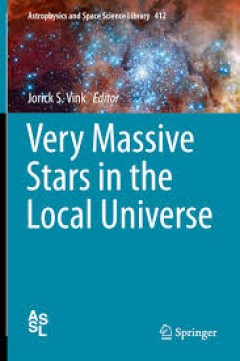Filter by

Viewing and Imaging the Solar System A Guide for Amateur Astronomers
Viewing and Imaging the Solar System: A Guide for Amateur Astronomers is for those who want to develop their ability to observe and image Solar System objects, including the planets and moons, the Sun, and comets and asteroids. They might be beginners, or they may have already owned and used an astronomical telescope for a year or more. Newcomers are almost always wowed by sights such as the…
- Edition
- -
- ISBN/ISSN
- 978-1-4614-5179-2
- Collation
- -
- Series Title
- -
- Call Number
- -

Very Massive Stars in the Local Universe
This book presents the status of research on very massive stars in the Universe. While it has been claimed that stars with over 100 solar masses existed in the very early Universe, recent studies have also discussed the existence and deaths of stars up to 300 solar masses in the local Universe. This represents a paradigm shift for the stellar upper-mass limit, which may have major implications …
- Edition
- -
- ISBN/ISSN
- 978-3-319-09596-7
- Collation
- -
- Series Title
- -
- Call Number
- -
Dark Energy as an Information Field and Attribute of the Universe
- Edition
- -
- ISBN/ISSN
- 978-1-83962-440-7
- Collation
- -
- Series Title
- -
- Call Number
- -

Asteroseismology of Stellar Populations in the Milky Way
The detection of radial and non-radial solar-like oscillations in thousands of G-K giants with CoRoT and Kepler is paving the road for detailed studies of stellar populations in the Galaxy. The available average seismic constraints allow largely model-independent determination of stellar radii and masses, and can be used to determine the position and age of thousands of stars in different regio…
- Edition
- Ed. 1
- ISBN/ISSN
- 978-3-319-10993-0
- Collation
- XIII, 185
- Series Title
- Astrophysics and Space Science Proceedings
- Call Number
- 520 AST a

The Formation and Disruption of Black Hole Jets
This book reviews the phenomenology displayed by relativistic jets as well as the most recent theoretical efforts to understand the physical mechanisms at their origin. Relativistic jets have been observed and studied in Active Galactic Nuclei (AGN) for about half a century and are believed to be fueled by accretion onto a supermassive black hole at the center of the host galaxy. Since the firs…
- Edition
- 1
- ISBN/ISSN
- 978-3-319-10356-3
- Collation
- XI, 264, 41 b/w illustrations, 46 illustrations in colour
- Series Title
- Astrophysics and Space Science Library
- Call Number
- -

The Earliest Stages of Massive Clustered Star Formation: Fragmentation of Inf…
This thesis presents an in-depth, high-resolution observational study on the very beginning of the formation process: the fragmentation of dense molecular clouds known as infrared dark clouds (IRDCs). Using the Submillimeter Array (SMA) and Very Large Array (VLA) radio interferometers, the author has discovered a common picture of hierarchical fragmentation that challenges some of the leading t…
- Edition
- 1
- ISBN/ISSN
- 978-3-662-44969-1
- Collation
- XX, 145, 14 b/w illustrations, 23 illustrations in colour
- Series Title
- Springer Theses
- Call Number
- -

Galactic Encounters Our Majestic and Evolving Star-System, From the Big Bang…
Written by William Sheehan, a noted historian of astronomy, and Christopher J. Conselice, a professional astronomer specializing in galaxies in the early universe, this book tells the story of how astronomers have pieced together what is known about the vast and complicated systems of stars and dust known as galaxies. The first galaxies appeared as violently disturbed exotic objects when the…
- Edition
- -
- ISBN/ISSN
- 978-0-387-85347-5
- Collation
- -
- Series Title
- -
- Call Number
- -

Astrophotography on the Go Using Short Exposures with Light Mounts
No longer are heavy, sturdy, expensive mounts and tripods required to photograph deep space. With today's advances in technology, all that is required is an entry-DSLR and an entry level GoTo telescope. Here is all of the information needed to start photographing the night sky without buying expensive tracking mounts. By using multiple short exposures and combining them with mostly ‘freeware�…
- Edition
- -
- ISBN/ISSN
- 978-3-319-09831-9
- Collation
- -
- Series Title
- -
- Call Number
- -

Fast Spectral Variability in the X-ray Emission of Accreting Black Holes
This thesis brings together the various techniques of X-ray spectral analysis in order to examine the properties of black holes that vary in mass by several orders of magnitude. In all these systems it is widely accepted that the X-ray emission is produced by Compton up-scattering of lower energy seed photons in a hot corona or accretion flow, and here these processes are examined through a stu…
- Edition
- -
- ISBN/ISSN
- 978-3-319-09587-5
- Collation
- XXXIII, 150
- Series Title
- -
- Call Number
- -

Viewing and Imaging the Solar System A Guide for Amateur Astronomers
Viewing and Imaging the Solar System: A Guide for Amateur Astronomers is for those who want to develop their ability to observe and image Solar System objects, including the planets and moons, the Sun, and comets and asteroids. They might be beginners, or they may have already owned and used an astronomical telescope for a year or more. Newcomers are almost always wowed by sights such as the…
- Edition
- -
- ISBN/ISSN
- 978-1-4614-5179-2
- Collation
- XIII, 256
- Series Title
- -
- Call Number
- -
 Computer Science, Information & General Works
Computer Science, Information & General Works  Philosophy & Psychology
Philosophy & Psychology  Religion
Religion  Social Sciences
Social Sciences  Language
Language  Pure Science
Pure Science  Applied Sciences
Applied Sciences  Art & Recreation
Art & Recreation  Literature
Literature  History & Geography
History & Geography